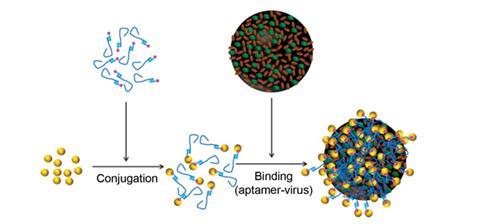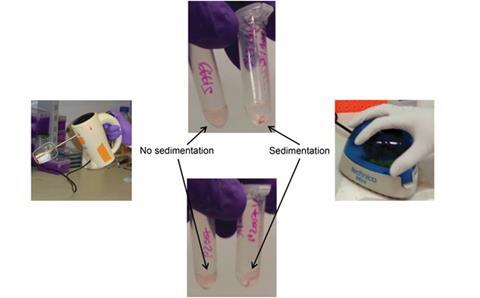Gold-coated flu viruses sink in visual bioassay
Researchers in the UK have developed a new visual bioassay that can detect flu viruses by making them heavier.
Early diagnosis is fundamental to slowing viral outbreaks. The latest (since 2003) outbreak of avian flu from Asia resulted in millions of chickens being culled and, according to the World Health Organization, the death of 393 people. Many laboratory-based tests, such as viral culture assays and the polymer chain reaction (PCR), are incredibly sensitive and accurate. However, they are costly, time consuming and require specialist training, so are unsuitable for transition to the field. It is therefore vital to introduce simple, quick and cheap field tests to control the spread of diseases and guide preventative measures, especially in countries like Vietnam where livestock is still a backyard affair.
The new bioassay, created by Antony Cass and coworkers at Imperial College London, uses aptamers tethered to gold nanoparticles. Aptamers are single-stranded DNA or, in this case, RNA strands, which bind to a specific target in a similar way to antibodies. They are, however, smaller, more resilient to denaturation and 1000 times cheaper to produce, making them ideal for field tests.
Colour changes indicate a positive reading in many field tests but nasal or gastrointestinal swabs tend to be dirty samples, so Cass’s team decided to focus on mechanical properties instead.

The aptamers were designed to recognise and bind to the haemagglutinin protein on the flu virus. Because the flu viruses are now effectively gold coated and therefore denser, they are easier to separate using a portable mini-centrifuge. Together with the addition of colour that gold gives to the viral pellet this test has a clearly visible endpoint that does not require laboratory based equipment. In fact, the same result can be obtained within 10 minutes by swapping the centrifuge for a domestic electric whisk. ‘Spinning the gold coated viruses down with an electric whisk gives you excellent discrimination in complex and somewhat dirty samples,’ explains Cass. Such an intrinsically simple bioassay could be used without much training and in-point-of-care platforms.

Biosensors expert Giovanna Marrazza from the University of Florence, Italy, says ‘this is further evidence of how creative use of aptamers can lead to a valuable new clinical test’. And according to Soyoun Kim, a biochip disease diagnosis expert from Dongguk University, Korea, this approach ‘provides alternative solutions for the quick and accurate detection of influenza viruses … suitable for many field applications’.
Ultimately the bioassay could allow livestock owners to manage the spread of influenza with routine field tests, to detect the virus before symptoms become obvious and infection is well established. Better sensitivity is required to make this possible but the first steps have now been taken.
References
This article is free to access until 24 December 2014. Download it here:












No comments yet